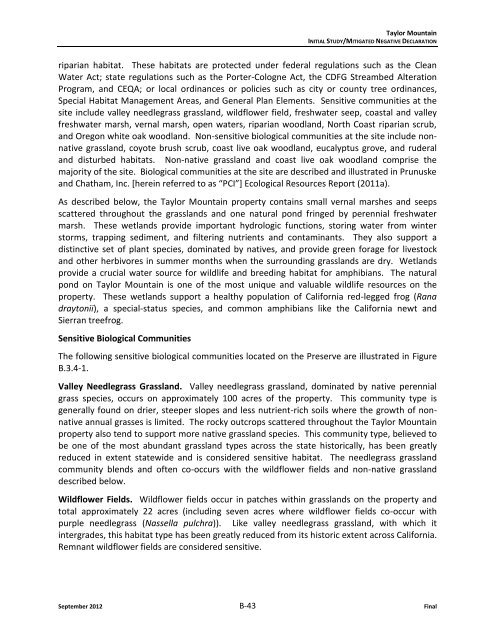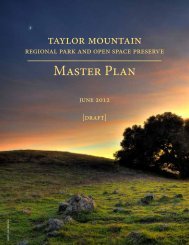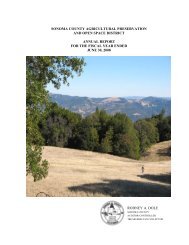Initial Study MND - Sonoma County Agricultural Preservation and ...
Initial Study MND - Sonoma County Agricultural Preservation and ...
Initial Study MND - Sonoma County Agricultural Preservation and ...
Create successful ePaper yourself
Turn your PDF publications into a flip-book with our unique Google optimized e-Paper software.
Taylor MountainINITIAL STUDY/MITIGATED NEGATIVE DECLARATIONriparian habitat. These habitats are protected under federal regulations such as the CleanWater Act; state regulations such as the Porter-Cologne Act, the CDFG Streambed AlterationProgram, <strong>and</strong> CEQA; or local ordinances or policies such as city or county tree ordinances,Special Habitat Management Areas, <strong>and</strong> General Plan Elements. Sensitive communities at thesite include valley needlegrass grassl<strong>and</strong>, wildflower field, freshwater seep, coastal <strong>and</strong> valleyfreshwater marsh, vernal marsh, open waters, riparian woodl<strong>and</strong>, North Coast riparian scrub,<strong>and</strong> Oregon white oak woodl<strong>and</strong>. Non-sensitive biological communities at the site include nonnativegrassl<strong>and</strong>, coyote brush scrub, coast live oak woodl<strong>and</strong>, eucalyptus grove, <strong>and</strong> ruderal<strong>and</strong> disturbed habitats. Non-native grassl<strong>and</strong> <strong>and</strong> coast live oak woodl<strong>and</strong> comprise themajority of the site. Biological communities at the site are described <strong>and</strong> illustrated in Prunuske<strong>and</strong> Chatham, Inc. *herein referred to as “PCI”+ Ecological Resources Report (2011a).As described below, the Taylor Mountain property contains small vernal marshes <strong>and</strong> seepsscattered throughout the grassl<strong>and</strong>s <strong>and</strong> one natural pond fringed by perennial freshwatermarsh. These wetl<strong>and</strong>s provide important hydrologic functions, storing water from winterstorms, trapping sediment, <strong>and</strong> filtering nutrients <strong>and</strong> contaminants. They also support adistinctive set of plant species, dominated by natives, <strong>and</strong> provide green forage for livestock<strong>and</strong> other herbivores in summer months when the surrounding grassl<strong>and</strong>s are dry. Wetl<strong>and</strong>sprovide a crucial water source for wildlife <strong>and</strong> breeding habitat for amphibians. The naturalpond on Taylor Mountain is one of the most unique <strong>and</strong> valuable wildlife resources on theproperty. These wetl<strong>and</strong>s support a healthy population of California red-legged frog (Ranadraytonii), a special-status species, <strong>and</strong> common amphibians like the California newt <strong>and</strong>Sierran treefrog.Sensitive Biological CommunitiesThe following sensitive biological communities located on the Preserve are illustrated in FigureB.3.4-1.Valley Needlegrass Grassl<strong>and</strong>. Valley needlegrass grassl<strong>and</strong>, dominated by native perennialgrass species, occurs on approximately 100 acres of the property. This community type isgenerally found on drier, steeper slopes <strong>and</strong> less nutrient-rich soils where the growth of nonnativeannual grasses is limited. The rocky outcrops scattered throughout the Taylor Mountainproperty also tend to support more native grassl<strong>and</strong> species. This community type, believed tobe one of the most abundant grassl<strong>and</strong> types across the state historically, has been greatlyreduced in extent statewide <strong>and</strong> is considered sensitive habitat. The needlegrass grassl<strong>and</strong>community blends <strong>and</strong> often co-occurs with the wildflower fields <strong>and</strong> non-native grassl<strong>and</strong>described below.Wildflower Fields. Wildflower fields occur in patches within grassl<strong>and</strong>s on the property <strong>and</strong>total approximately 22 acres (including seven acres where wildflower fields co-occur withpurple needlegrass (Nassella pulchra)). Like valley needlegrass grassl<strong>and</strong>, with which itintergrades, this habitat type has been greatly reduced from its historic extent across California.Remnant wildflower fields are considered sensitive.September 2012 B-43 Final







